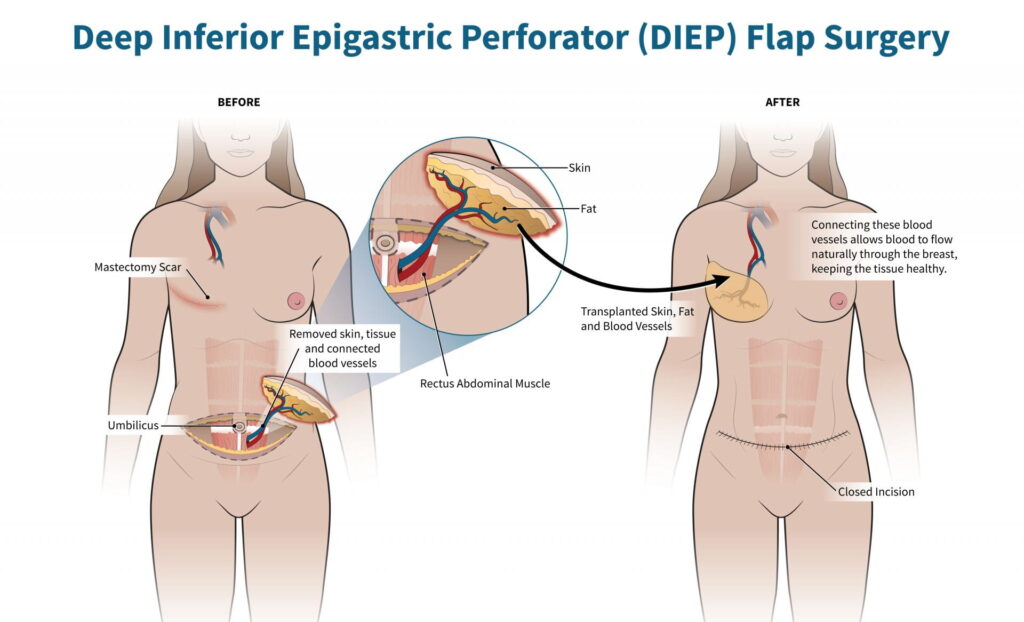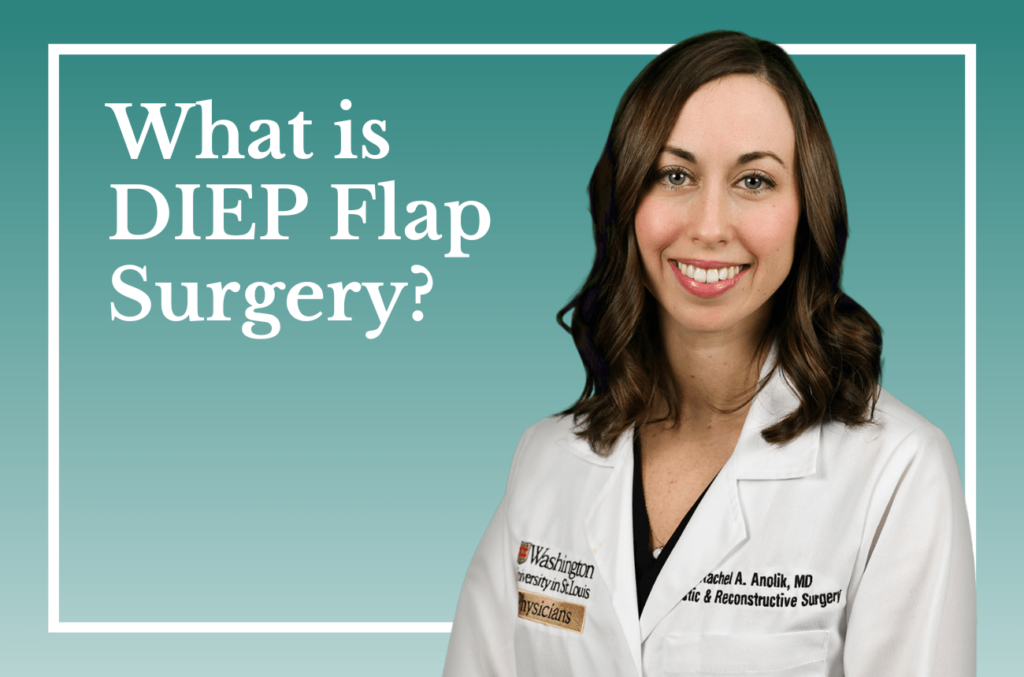After having a mastectomy for breast cancer, women may decide to have breast reconstruction surgery to restore the shape and appearance of their breast. There are different types of breast reconstruction surgery, including implant reconstruction and tissue reconstruction. Tissue reconstruction, also called flap surgery, uses skin and fat from another part of the body to rebuild the breast.
DIEP (deep inferior epigastric perforator) flap surgery takes skin, fat and blood vessels from the abdomen and moves them to the chest to form a breast.
Washington University plastic and reconstructive surgeon Rachel Anolik, MD, notes that DIEP flap surgery is a newer form of breast reconstruction, not available at many centers. The procedure requires microsurgical skill to operate on blood vessels and other tiny structures throughout the body. Washington University breast surgeons have advanced fellowship training in microsurgery and perform a high volume of surgeries using the latest reconstructive techniques at one of the nation’s top hospitals.
How is DIEP flap surgery performed?
There are two main stages to DIEP (pronounced “deep”) flap surgery. First, the surgeon removes skin, tissue and connected blood vessels from the lower abdomen or tummy. Then the surgeon transplants the skin and fat to the chest and connects the DIEP vessels to blood vessels beneath the ribs. Connecting these blood vessels allows blood to flow naturally through the breast, keeping the tissue healthy. The surgeon uses microscopes and special surgical tools to tie the blood vessels together, which requires expertise in microsurgery.
Many patients have a CT scan of the abdomen and pelvis before DIEP flap surgery. This scan uses a contrast to make the blood vessels in the area “light up” on the imaging.
“That helps us zero in on blood vessels that might have the most direct path through the muscle, are in a good location on the flap, and look like they will perfuse the area of tissue we will use for the breast reconstruction,” says Dr. Anolik, who is part of a team of Washington University plastic and reconstructive microsurgeons with advanced training and experience in DIEP flap surgery.

What are the benefits of DIEP flap surgery?
DIEP flap surgery uses your own tissue to rebuild the breast. This usually results in a more natural look and feel than implant reconstruction. Tissue reconstruction also tends to be more long-lasting than an implant, which sometimes need to be replaced. Since DIEP flap surgery uses tissue from the tummy area, this procedure can also create a slimmer appearance. Unlike some other types of flap procedures, DIEP flap surgery does not remove any abdominal muscle. A DIEP flap can look more natural than other flaps, since there is not a visible bulge of muscle in the flap. Leaving the rectus abdominis muscle intact also helps preserve core strength, reduce the risk of a hernia and shorten recovery time.
What are the disadvantages of DIEP flap surgery?
Like other flap procedures, DIEP flap surgery involves 2 surgical sites: one on the abdomen and the other on the chest. In general, recovery after tissue reconstruction tends to take longer than with implant reconstruction. Flap surgery also leaves 2 scars. Scars may fade with time, but will not completely disappear. While it is considered a state-of-the-art technique for breast reconstruction, DIEP flap surgery may not be right for everyone. The best type of reconstruction for you depends on your overall health, goals for after surgery and other factors. Your surgeon can discuss the benefits and drawbacks of each kind of breast reconstruction and help you during the decision-making process.
Washington University Breast Reconstruction
Washington University plastic and reconstructive surgeons are leading experts in microsurgical techniques for breast reconstruction. Our skilled, compassionate surgeons work alongside breast cancer specialists at Siteman Cancer Center to provide comprehensive cancer care from initial diagnosis to oncologic reconstruction. If you are considering breast reconstruction after mastectomy, you may have multiple options, including DIEP flap surgery, other types of flap procedures, and implant reconstruction. No matter what type of reconstruction is right for your goals, Washington University plastic and reconstructive surgeons have the expertise and dedication to help you achieve your best outcome.
To schedule an appointment with a Washington University plastic and reconstructive surgeon, please call 314-362-7388 or fill out an online appointment form.
